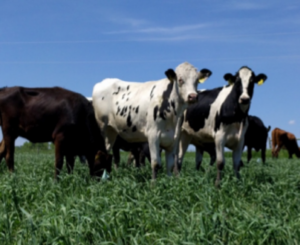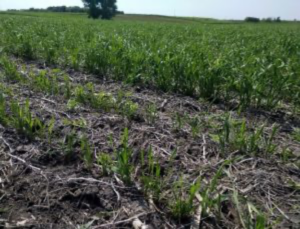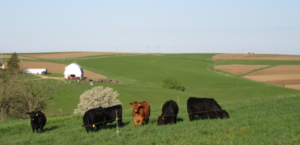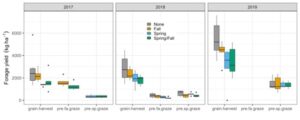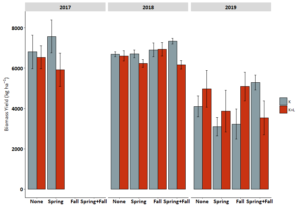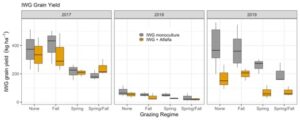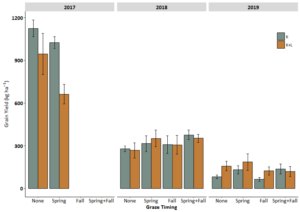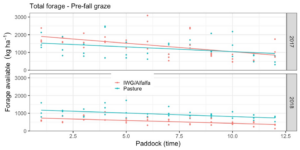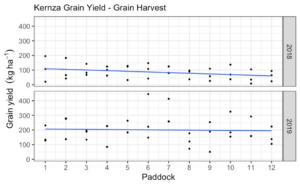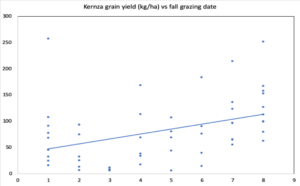Final report for LNC16-383
Project Information
Intermediate wheatgrass (Thinopyrum intermedium) is a perennial cool-season forage grass that has been bred for large seed size and yield becoming the first perennial grain crop in the US. Research and industry partnerships have achieved rapid development of this crop; commercial interest in Intermediate wheatgrass grain (Kernza ®) has swelled and demand is greater than farmers’ supply. Kernza production has great potential to improve agricultural sustainability compared to annuals because its extensive root systems reduce soil erosion and nutrient leaching, while simultaneously increasing farmer incomes due to decreased annual inputs and costs.Ongoing agronomic trials are determining best management practices for maximum grain yield. However, an added-value product remains largely untapped and unknown: the capacity to manage Intermediate wheatgrass as an integrated crop/livestock system to produce forage for livestock and grain for humans. Forage provides another revenue stream, reducing economic risks for farmers. Because Intermediate wheatgrass grain is harvested in mid-summer, there is potential to harvest or graze its forage in the Spring and Fall, but little is known about the impact of grazing timing on grain and forage production. Therefore, our objectives are to measure: 1) Intermediate wheatgrass grain yields after being grazed in Spring, Fall, or both seasons, and 2) forage yield, forage quality, and animal performance from grazed Intermediate wheatgrass. Improved Kernza ® seeds will be planted for experiments at four on-farm sites in Minnesota and Wisconsin, and at two university research farms (UMN-Morris and UW-Lancaster). We will conduct an economic analysis that considers inputs and returns to optimize grain and forage yields that enhance farmer profitability and environmental sustainability.This project responds directly to farmer-driven questions about production as a dual-purpose crop for grain and livestock. This project was designed with input by the participating farmers, and results will serve a much larger farmer constituency. Results will be communicated at field days and producer meetings, published as a “Kernza growers’ handbook”, peer-reviewed papers, conference presentations, and through the Green Lands Blue Waters website, e-newsletters and outreach networks. Farmers will learn how to profitably manage Intermediate wheatgrass for forage and grain production. Outcomes will facilitate the expansion of this crop so more seed and grain will be available to farmers and industry. In the long term, this will increase economic benefits to farmers and rural communities, provide new whole grain food products, and improve soil and water quality through perennial cover in the North Central US.
Learning: Farmers and researchers will learn about: - Intermediate wheatgrass forage and grain yield response to grazing in Fall and/or Spring, - livestock performance on Intermediate wheatgrass forage, - potential economic returns from Intermediate wheatgrass, - how to manage Intermediate wheatgrass for both forage and grain
Action: - More farmers will grow and graze Intermediate wheatgrass. - More seed and grain will be available to farmers and industry. - Increased collaboration among Intermediate wheatgrass researchers in the Upper Midwest.
System: - Increased planting of Intermediate wheatgrass will improve the economic and environmental sustainability of agriculture in the North Central US.
The outputs of this project include the generation and dissemination of results and information, as well as other products detailed below.
Experimental results and information: Results from this project will be available as soon as data are collected and processed. Near-term results will include: 1) Intermediate wheatgrass forage and grain yield response to one and two years of Spring grazing, Fall grazing, and both. 2) Comparison of livestock performance of animals grazing improved pasture vs. Intermediate wheatgrass regrowth. 3) Estimated economic returns from forage and grain products in each treatment combination.
Products: 1) A best management guidelines document for integrated crop/livestock management of Intermediate wheatgrass (“Kernza growers’ handbook”). This will be on-line at the Green Lands Blue Waters, Forever green website, UMN and UW Extension websites. 2) Four field days demonstrating the dual-use potential of Intermediate wheatgrass in Minnesota and Wisconsin (Experimental stations and participating farms). 3) Peer-reviewed publications published in open-source journals. 4) Posters available online summarizing research for regional and national conferences 5) An interdisciplinary and participatory network of farmers, researchers, Extension agents, educators, industry, and other collaborators interested and actively engaged in promoting research, growing, and marketing of Kernza 6) Kernza seed for future research and industry.
Many landscapes in the Upper Midwest include topography where annual crop production places soils at high risk for erosion. Perennial crops can improve agricultural sustainability compared to annuals because their extensive root systems can sequester carbon, reduce soil erosion and nutrient leaching, and minimize pesticide requirements while simultaneously increasing farmer incomes due to decreased annual inputs and costs (Glover
et al., 2010). Strategic placement of sensitive lands into perennials will help improve water quality by reducing erosion and nutrient runoff (Asbjornsen et al., 2014). Expanding the area in perennial crops will benefit citizens in the whole Mississippi River basin.
Many producers in the Midwest are interested in alternative cropping systems that better protect soil resources, including continuous living cover crops, such as forages and perennial crops. Development of multiple and profitable markets for perennial crops will help reduce the economic risk of planting these crops and will benefit farmers by helping them increase their crop diversity and resilience, profitability, and meet environmental
regulations.
Intermediate wheatgrass (Thinopyrum intermedium L.) is a perennial cool-season forage grass that has been bred for large seed size and grain yield so that it can become the first perennial grain crop in the US (DeHaan et al., 2010). This grass has great potential as a human food while providing environmental benefits. It has an extensive root system that has potential to limit nitrate leaching into groundwater (Culman et al., 2013; Smith et al., 2013) and provide year-round ground cover and reduce soil erosion. Increasing Intermediate wheatgrass area and production in the North Central US will improve environmental sustainability.
Rapid development of Intermediate wheatgrass has been achieved by research in genetics, breeding, agronomic management, and end products. Therefore, commercial interest in Intermediate wheatgrass grain – called Kernza ® (DeLage, 2015) - has swelled in recent years. There is interest in Kernza from multiple food industry stakeholders (e.g., General Mills, Patagonia Provisions, Chipotle, Ventura Spirits, Death’s-Door Spirits, Birchwood
Cafe, Bien Cuit bakery, among others). Currently, food industry demand for Kernza is greater than the farmers’ capacity to grow it, hence the current limitation is the lack of supply. National food companies have initiated contracts with farmers who are excited about diversifying their rotations with the new grain crop. These farmers have noticed lush Intermediate wheatgrass forage growth in the Spring and Fall and have asked researchers if it
could be grazed. Farmers consider the forage another revenue stream and grazing as a way to minimize risk from growing the new Intermediate wheatgrass crop solely for grain. As a forage grass, Intermediate wheatgrass is productive and has relatively high quality forage (Asay, 1995; Nelson et al., 1989), suggesting it will have value as a dual use crop. In preliminary trials at University of Minnesota, it was found that vegetative forage can be mechanically harvested in April prior to grain harvest (see Figure 1), or after grain harvest in Fall; however, the impact of grazing on subsequent grain yield is unknown.
Research suggests that grazing could either be beneficial or detrimental to grain production, depending on stocking rates and timing (Hendrickson et al., 2005; Young et al., 1996). By manipulating timing as proposed in this research, our objective is to determine when to graze Intermediate wheatgrass so that long-term grain yields are maintained. At the right timing, the physical impact of grazers can disturb soils enough that plant density in sod-bound pastures can recover (Hendrickson et al., 2005). We will determine if a similar phenomenon occurs in Intermediate wheatgrass and if seed yields can be maintained as stands mature.
This research will develop information about management of this new perennial grain crop for dual use as a forage and grain. As a forage, it may also expand the season for grazing early in the Spring and late in the Fall. This increases sustainability of farms, particularly those with limited resources, by increasing the efficiency of land use through multiple avenues of potential income generation. Having various potential uses also improves its chances of increasing farmer income and adoption by farmers. Widespread farmer adoption of the crop will also create a positive feedback loop of adequate supply of grain to develop a robust value chain for the grain. Direct beneficiaries from inclusion of Intermediate wheatgrass on the North Central US region landscapes include farmers who seek alternative crops that require fewer inputs, livestock managers interested in pastures that provide additional economic returns, and the seed processing industry. In addition, all Midwesterners will benefit from the availability of a healthy whole grain food and improved environmental quality.
This project builds on knowledge and products generated on previous NCR SARE projects. According to the SARE database, NCR SARE has funded 213 projects mentioning the problem of soil erosion, and 21 projects explicitly mentioning nutrient leaching. More projects have focused on cover crops (310 projects) than perennials (forages and trees mainly, 272 projects). Only 5 projects have focused on perennial grain crops, including Intermediate wheatgrass. In 2005, Liebman et al. (GNC05-055) studied polycultures of perennial multiple purpose crops in Iowa (Illinois bundleflower, Intermediate wheatgrass and switchgrass) finding that Intermediate wheatgrass had high potential as a forage mixed with legumes. In 2006, DeHaan et al., (LNC06-274) advanced the domestication of Intermediate wheatgrass, doubling the seed size and yield in few selection cycles. In the final report of this project, the potential for Fall grazing and hay utilization was already identified as a future research direction. A second NCR SARE grant was awarded to DeHaan et al. (2010, LNC10-319) on participatory breeding and agroecology to develop Intermediate wheatgrass for sustainable grain production. As a result of these longterm efforts, breeding of this perennial grain has expanded to two other universities, agronomic management research has expanded to a network of more than ten universities, food companies are promoting Kernza grain production, and farmers are interested in trying this new crop. Therefore, this proposal contributes directly to the three broad based NCR-SARE outcomes by generating
knowledge to improve the profitability of farmers, improving the environmental quality of the region, and enhancing the quality of life for farmers/ranchers, communities, and society as a whole. Learning how to grow and graze this new perennial dual purpose crop will certainly contribute to these three relevant sustainability outcomes.
Cooperators
- (Researcher)
- (Researcher)
- (Researcher)
- (Educator)
- (Researcher)
- (Researcher)
- (Researcher)
- (Educator)
- (Researcher)
- (Researcher)
- (Researcher)
- (Educator)
Research
This project address three research questions:
1) In Intermediate wheatgrass fields managed for grain and forage, how does timing of grazing affect Kernza grain yields, forage yield and quality, and economics when livestock graze in Spring, Fall, or both Spring and Fall?
2) Do these effects differ when intercropping Intermediate wheatgrass with legumes (alfalfa or red clover) vs Intermediate wheatgrass in monoculture?
3) How much biomass can be harvested by grazing, what is the quality of that forage, and how does that forage affect livestock weight gain and economic performance when grazed in Fall?
Experimental design
Experiment 1. Grazing Intermediate wheatgrass - on farm. This experiment took place on eight farms, four in Minnesota and four in Wisconsin, spanning organic and conventional management, on beef or dairy farms. The experiment plan was to compare grazing of intermediate wheatgrass forage in spring, fall or ungrazed control. Problems with intermediate wheatgrass establishment in most farms made us change the focus from comparing grazing timing to evaluating overall performance of Kernza harvested for grain and forage on farm.
Experiment 2. Grazing Intermediate wheatgrass intercropped with legume.
General description: At two experimental stations (UMN Morris WCROC, and UW Lancaster ARS) we established a factorial experiment with two factors: grazing timing of Intermediate wheatgrass and intercropping with legume. The grazing timing factor had 4 levels: spring, fall, spring and fall, and ungrazed control. The Spring grazing was around May 1 when Intermediate wheatgrass plants are leafy/vegetative and about 12 inches tall. The first node was identified in the stem about 1 inch from the plant crown. Fall grazing was conducted in mid-October, about two months after grain harvest. The experimental design was a randomized complete block with a split-plot arrangement of treatments. There were three replicates per site. Whole plots were the timing of grazing treatments and subplots were Intermediate wheatgrass with intercropped with a legume (alfalfa or red clover) and Intermediate wheatgrass monoculture. The Intermediate wheatgrass monoculture was fertilized with 60 lb of nitrogen in the Spring. Forage yields were determined by clipping and weighing biomass from quadrats. A biomass subsample was then be ground to pass a 2 mm screen to then determine forage nutritive value using near infrared spectroscopy calibrated with wet chemistry. Forage nutritive value metrics included crude protein, neutral detergent fiber, acid detergent fiber, neutral detergent fiber digestibility, and in vitro true digestible dry matter. Using these measures relative forage quality was determined. Grain yields for Intermediate wheatgrass were determined in early August each year when grain reached physiological maturity by harvesting quadrats from each paddock. Seeds were removed from seed heads using a research-scale thresher and then weighed. A straw subsample was dried to determine straw yield. Remaining grain and straw were machine harvested with a combine and removed from the paddocks. Measurements were taken for three years (2017-2019).
Minnesota: Intermediate wheatgrass was established in fall of 2016 at Morris, MN, and overwintered to form a healthy stand in the spring of 2017. Alfalfa was successfully established by Brillion seeding at 15 lb/acre on the appropriate split plots in early May of 2017 prior to spring grazing. The trial was laid out in a randomized complete block design with three replications, in 30 x 80 ft. split-plots. In June of 2017, baseline soil samples were collected in each plot in depth increments of 0-15, 15-30, and 30-60 cm, and analyzed for N, P, K, pH, and SOM. Baseline bulk density samples were collected at depth increments of 0-15, 15-30, 30-45, and 45-60 cm in all plots. Baseline bulk density values at the Morris site ranged from 1.01 to 1.09 in the surface fraction, and from 1.28 to 1.59 in the deepest fraction. Prior to spring grazing, IWG biomass was collected from four randomly placed 0.25 m2 quadrats per plot, dried in an oven for three days at 55 degrees C, and weighed. The spring grazing treatment was performed by ~30 dairy heifers on June 6th, 2017 and June 25th, 2018, when the IWG reached a growth stage just prior to elongation (Figure 1). The heifers were moved across all plots receiving a spring grazing treatment over a period of 24 hours to maintain an IWG stubble height of 3 to 4 inches. The grazing management was successful and grazing was generally uniform across the field (Figure 2) with a stubble height sufficient to protect the developing seedhead near the IWG crown. Post-graze biomass was collected using the same methods as described for pre-harvest sampling. Prior to mechanical harvest, IWG spikes, straw biomass, and weeds were collected separately from 2 randomly placed 0.42 m2 quadrats per plot, and dried in an oven for three days at 55 degrees C. Harvest of IWG was performed at the beginning of August by swathing and combining. Seedheads were threshed on a Wintersteiger research thresher and IWG straw and alfalfa are being analyzed for forage quality using NIR. The same biomass collection and analysis procedures used in the spring were employed before and after the fall grazing event. Fall grazing was performed by ~30 dairy heifers on November 13, 2017 and November 26, 2018. Due to low forage availability in fall of 2018, mean residual height was ~2 inches.
Figure 1. Dairy heifers grazing intermediate wheatgrass in spring 2017 at Morris, MN
Figure 2. IWG receiving spring grazing in the foreground (first two rows), compared with non-spring-grazed IWG in the background, at Morris, MN.
Wisconsin: Intermediate wheatgrass was established on 12 acres in the fall of 2016 at the Lancaster ARS and intercropped with red-clover in a split-plot design (Figure 3). It overwintered well and grew to a healthy stand by the spring of 2017, except for a 2-acres area that it was no-tilled onto a sprayed pasture. In that area weed grasses germinated in the fall and dominated the area (80% of aboveground biomass were weeds), so it had to be excluded from the experiment. The trial was therefore laid out over the remaining 10 acres in a split-plot design with three blocks where the grazing treatments were randomly assigned. Baseline soil samples were collected in each paddock at depths of 0-15, 15-30, and 30-60 cm according to the same protocol described above.
Figure 3. Kernza monoculture (right) and Kernza-red clover mixture (left) in 2017 at Lancaster, WI.
Prior to spring grazing, IWG biomass was collected from four to six randomly placed quadrats per plot (depending on paddock size), dried in an oven for three days at 55 degrees C, and weighed. The spring grazing was performed by 78 dairy heifers on May 4th 2017 when the IWG reached a growth stage just prior to elongation. The heifers grazed on all plots receiving a spring grazing treatment over a period of 24 to 48 hours in order to graze the IWG down to a stubble height of 4 inches. Grazing was generally uniform across the field. Grain harvest of “Kernza” IWG was performed by swathing the stand on July 29 2017 and combining after the plants had dried in windrows for 5 days. Prior to swathing, IWG spikes, forage (straw), red-clover and weed biomass were collected separately with 4 to 6 randomly placed quadrats per plot and dried in an oven for three days at 55 degrees C. Forage left after combining was baled on the same day and analyzed for quality by wet chemistry analysis. Fall grazing was conducted with beef steers (Figure 4).
Figure 4. Beef cattle grazing Kernza intermediate wheatgrass at Lancaster, WI.
Experiment 3. Strip-grazing Intermediate wheatgrass in the Fall: forage yield and grain yield, cattle performance and economics.
General description: We compared forage yield and quality, subsequent grain yield, cattle performance and economics when grazing grass-legume mixtures of Intermediate wheatgrass vs. an improved pasture. Two grass-legume mixtures were established (Intermediate wheatgrass-alfalfa and orchardgrass-meadow fescue-alfalfa pasture), at two experimental research stations (UW Lancaster and UMN Morris). A total area of 9 acres of each pasture type was prepared, each experimental unit (paddock) was 3 acres. Experimental design was a randomized complete block with three replications per location and two treatments. Intermediate wheatgrass seeds were planted into 12-inch rows at a rate of 9 lbs. per acre with 9 lb. per acre grazing type alfalfa included. The conventional grass-legume pasture treatment was broadcast seeded at 12 lb. per acre of orchardgrass and meadow fescue along with 9 lb per acre grazing type alfalfa. This pasture was hayed 3 times per season with the last harvest occurring about the time Intermediate wheatgrass is harvested for grain. Therefore, grasses would be at a similar developmental stage when grazing occurs in the Fall treatment. Each pasture was simultaneously grazed using a strip grazing technique, which allows cattle access to new areas of forage until available forage is utilized (Undersander et al., 2002). A forward electrified wire limits the size of the new forage area to be grazed while a back wire prevents grazing of regrowth. Individual strip size was about 0.25 acres. Within each 3-acre paddock, a 25 ft.2 grazing exclusion was be maintained as an ungrazed control. Heifers (dairy or beef) grazed in mid-September after Intermediate wheatgrass grain and straw have been harvested in August and vegetative regrowth reached a height of 8 inches. Cattle was weighed in pasture at beginning and end of the experiment. We used linear regression to measure the effect of grazing time (in Fall) on subsequent grain yields.
Minnesota: In Morris, MN, grazing was conducted in 2017 and was repeated for a second time in 2018 and both fields contained alfalfa as a legume. Groups of three replacement dairy heifers were grazed from October 19th to November 11th and were moved every two days among equal-sized paddocks.
Wisconsin: In Lancaster, WI, forage availability was monitored weekly and paddock size was adjusted at every rotation to maintain constant forage allowance throughout the trial. Animals were moved to a new pasture every three to four days in a strip grazing system. The intermediate wheatgrass pasture was in its first production year and was intercropped with alfalfa on 20 march 2018 and the improved pasture was composed of an established stand of orchardgrass, tall fescue, smooth bromegrass and red clover.
Experiment 1: Dual-purpose management on farms
At Minnesota, experiments were started at three collaborating farms, with variable outcomes.
At Mike Jorgenson’s farm in Clinton, MN, IWG was planted in fall of 2016 with a poor establishment and the IWG winterkilled, resulting in poor stands in the spring of 2017. It was decided to terminate the stands. IWG was established again at the beginning of September of 2017. This stand also failed by summer of 2018 due to chronically wet soils in a low-lying field without subsurface drainage. While we were not able to implement the grazing treatments at this site, we did learn that intermediate wheatgrass is not adapted to wet MN soils.
At Jesse and Judy Theis’s farm New Prague, MN, IWG was planted in fall of 2016, also with poor establishment and winterkill, so it was also terminated and re-established in fall 2017. The IWG over-wintered well. However, the farmers were concerned about weed pressure and decided to cut it for hay in mid-summer. The IWG regrew vigorously in the fall. Plots were established and the fall-graze plots were grazed on October 22-26, 2018. Average forage yield in fall was 0.8 tons of dry matter per acre. Grain yields were measured from grazed and ungrazed areas in summer 2019. Average grain yield in the control plots (ungrazed) was 1004 lb/ac, while yields in the grazed fields were 1306 lb/ac. This difference was not statistically significant based on a sample size of 4 in each treatment. Anecdotes of cattle preference were very positive. Jesse described the cattle as “loving the Kernza forage”.
At Goplen farm in Canby, MN IWG was established in mid-September of 2017. IWG over-wintered well, but heavy weed pressure caused the farmer to bale and remove the biomass at grain harvest time in August, before weeds set seed. Again, regrowth was strong, so plots were established and the fall-graze plots were grazed starting on October 30th 2018. Forage yield prior to grazing averaged 0.9 tons per acre and averaged 0.3 tons per acre of residual biomass after grazing. This 66% utilization rate is exactly what we were achieving for this mob graze event. A subsequent spring mob graze was administered between May 21 and 24 2019. Forage yields prior to the spring graze were 1.3 tons per acre and post-graze forage availability was 0.6 tons per acre. Grain was harvested from quadrats that were grazed paddocks of the following treatments: spring only, fall only, spring + fall, and ungrazed. Although there were no statistically significant differences between grain yields across treatments, the mean yield was highest in the ungrazed control (1400 lb/ac), followed by fall grazing (1250 lb/ac), spring grazing (850 lb/ac) and spring+fall (800 lb/ac).
At Wisconsin experiments were started at four collaborating farms, with variable outcomes:
At Gene Shriefer’s Rolling Hills Stock Farm in Dodgeville, WI, IWG was no-tilled on an 8-acre field in Dodgeville in mid-September 2016. Previous crop was a pasture, previously killed with herbicide. Competition, mostly from grasses, lead to poor establishment, and by the spring 20217 biomass of IWG was only 20 % of total biomass. By September 2017, we agreed to discontinue the “Kernza” experiment and manage the field for hay.
At Lizzie and Jake Haucke’s farm in Viroqua, WI, IWG was planted in a 10-acre field in late October 2015 on a disked pasture. Here also grass weed competition lead to poor establishment. In May 2017, biomass from IWG averaged 7% of total vegetation biomass. This experiment was also discontinued and managed for hay.
At Jason Biddick’s farm in Livingston, WI, a 14-acre field IWG was planted on 17 September 2017 on a field previously planted with soybeans. Establishment worked well, likely due to an early planting and low weed seedbank of the field site previously cropped with soybean. In 2018, grain was harvested on 4 August 2018 and the fall regrowth was harvested for hay early November. Grazing treatments were not applied, but forage the entire field was harvested and baled in the spring 2019.
At Gabriel Slatery’s Devil’s Hole Ranch in Norwalk, WI, a 10-acre field was planted on certified organic ground previously cropped with a 3-years old grass-alfalfa mixture. Stand termination and seedbed preparation was performed by disking the stand four times over the first two weeks of September 2017, after which intermediate wheatgrass was drilled with a no-till drill on 12 September, 2017. This method of sward termination proved to be ineffective, as the alfalfa regrew into a solid stand in the spring of 2018 and outcompeted the establishing intermediate wheatgrass. In summer of 2018, we decided to investigate another potential alternative to establish intermediate wheatgrass in an organic farm. First, the standing 3-years-old grass-alfalfa stand was plowed on 25 August 2018 and seedbed preparation was performed by disking the soil three times and finishing it with a cultimulcher. Then intermediate wheatgrass was planted at wide row-spacing of 30 inches, on 26 August 2018. This wide row-spacing is widely used in seed production of range grasses and will allow to control weeds mechanically with a cultivator. Cultivation was performed in the spring of 2019.
These eight farmer experiences were extremely relevant to inform new research and farmer recommendations on the critical period of establishment of Kernza intermediate wheatgrass. Although the goal of testing the effect of different grazing times was not accomplished in all the farms, these experiences were very valuable to learn about management of this new crop in the Upper Midwest.
Experiment 2: Grazing timing of IWG with and without legume intercrop
Forage yield
Figure 5. Boxplots showing means and dispersion of forage yield (kg ha-1) of Kernza intermediate wheatgrass at grain harvest (summer), before spring grazing, and before fall grazing, for 4 grazing timing treatments (ungrazed control, fall only grazing, spring only grazing, and spring and fall grazing) for three years (2017, 2018, 2019) at Morris, MN.
In 2017 spring + fall grazing reduced the 2018 forage and straw yield (Figure 5). In 2018 mean forage yields were in the range of 400-650 kg ha-1 in the spring and 200-450 kg ha-1 in the fall. Neither grazing nor alfalfa intercropping affected spring or fall forage yields. Forage production was highest at grain harvest, when crop residue yields averaged 2200 kg ha-1. Grazing tended to depress crop residue yields at grain harvest, with mean yield of 1900 kg ha-1 in the two spring-grazed treatments and 2900 kg ha-1 in the no-graze control. In the intermediate wheatgrass-alfalfa biculture in Morris, alfalfa made up 22, 24, and 51% of the forage biomass in the spring, summer, and fall, respectively. Forage yields increased in 2019 after fertilization. Grazing reduced straw yields in 2019.
Figure 6. Bar graph showing means and standard error of forage yield (kg ha-1) of Kernza intermediate wheatgrass at grain harvest (summer) for 4 grazing timing treatments (ungrazed control, spring only grazing, fall only grazing, and spring and fall grazing) for the two intercropping treatments (monoculture and mixture with red clover) for three years (2017, 2018, 2019) at Lancaster, WI.
Forage dry matter yields were similar between vegetation treatments in Lancaster, WI (Figure 6). In the first year, 2017, red clover competed with Kernza and reduced the Kernza biomass at summer. There were no differences in 2018. Averaged across grazing treatments, the proportion of red clover in the total harvested biomass at grain harvest was 5% in 2018, compared to 35% in 2017. In 2019 Kernza biomass was higher in red clover plots, except for the treatment with spring and fall grazing. The effect of grazing was not very clear and no statistical differences were found. However, there was a trend of higher Kernza biomass in the spring +fall grazed plots in monoculture, and a reduction in the mixture.
Grain yield
Figure 7. Boxplots showing means and dispersion of grain yield (kg ha-1) of Kernza intermediate wheatgrass for 4 grazing timing treatments (ungrazed control, fall only grazing, spring only grazing, and spring and fall grazing) and two intercropping treatments (monoculture and mixture with alfalfa) for three years (2017, 2018, 2019) at Morris, MN.
Spring grazing reduced grain yields (Figure 7) likely due to grazing opened up the IWG canopy, allowing warm-season weed pressure to increase rapidly, compared to non-spring-grazed treatments. The field in which the study was conducted has a considerable seedbank of common ragweed, which was evident in the spring grazed treatments. Yields fell drastically in 2018 as a result of N and P limitation and wet and cold spring. Grain yields decreased in comparison to the first growing season with an average across all treatments of 41 kg ha-1 in 2018 versus 300 kg ha-1 in 2017. Both grazing and competition with the intercropped alfalfa reduced grain yield (p=0.05) at this site in 2018, potentially due to lower soil fertility and stand vigor. Organic manure amendments helped yields recover in 2019. Kernza monoculture yields were greater than alfalfa intercrop yields overall.
Figure 8. Kernza grain yields for 4 grazing timing treatments (ungrazed control, fall only grazing, spring only grazing, and spring and fall grazing and two intercropping treatments (monoculture and mixture with alfalfa) for three years (2017, 2018, 2019) at Lancaster, WI. In 2017, no fall grazing had yet been applied; therefore, only “none” and “spring” grazing effects are depicted. Crop culture treatment codes are “K” = Kernza monoculture; “K+L” = Kernza + red clover mixture. Bars depict standard error of the mean.
In 2017/year 1 of the stand, spring grazing decreased Kernza grain yields by 100 kg ha-1 (p = 0.042), compared to the no-graze control (Figure 8). Intercropping Kernza with the legume red clover also decreased yields by 180 kg ha-1 (p = 0.006). Grain yields declined from year 1 to year 2 by 620 kg ha-1 on average. There was no significant interaction between intercropping (monoculture vs. intercropped with red clover) and grazing treatments. Neither grazing treatment nor crop culture treatments affected Kernza grain yields in 2018, year 2 of the stand (Figure 8). In 2019, year 3 of the stand, grain yields across all treatments were 195 kg ha-1 lower than year 2 grain yields, and grazing had no effect on grain yields. Intercropping Kernza with red clover increased yields by 75 kg ha-1 (p = 0.070).
In summary, grazing decreased yields in year 1, possibly due to graze timing that harmed Kernza flower development in the sheath. This decrease was especially notable in the spring-grazed biculture; it is possible that cattle grazed at a lower height to access the red clover near ground surface and consequently harmed the new Kernza stand to a greater extent than years 2 and 3, where grazing exerted a marginally beneficial effect on Kernza grain yields (+40 kg ha-1, p = 0.094), averaged across the mono- and bicultures.
Given that effects of grazing and mono- vs. biculture treatments differed among years, it may be useful to consider the cumulative grain yields within a treatment; i.e., the sum of grain yields across years 1 through 3, to elucidate which treatments produced the most grain over the life of the stand. Grain yields in the Kernza monoculture trended higher with fall grazing compared to the control and spring graze only treatments (Table 1). In the biculture stands, fall grazing significantly increased Kernza grain yields compared to the control and spring+fall grazed stands (Table 1).
Table 1. Cumulative Kernza grain yields in Lancaster, WI, summed over three years. Different letters indicate significant differences within intercropping treatments.
|
Culture |
Graze |
Grain Yield (kg ha-1) |
Std. err (kg ha-1) |
|
|
|
|
|
|
Kernza |
Control |
1451 a |
71 |
|
Kernza |
Spring |
1405 a |
44 |
|
Kernza |
Fall |
1513 a |
183 |
|
Kernza |
Spring+Fall |
1610 a |
71 |
|
|
|
|
|
|
Kernza+Legume |
Control |
1026 b |
57 |
|
Kernza+Legume |
Spring |
1234 b |
28 |
|
Kernza+Legume |
Fall |
1621 a |
232 |
|
Kernza+Legume |
Spring+Fall |
1090 b |
90 |
Lodging
In 2018 a positive effect of the spring grazing was detected on lodging in Lancaster, WI, where the lodging incidence was reduced from 41 to 12 in the non-grazed compared to the spring-grazed, respectively, on a scale of 100 (Figure 10). No vegetation effect was observed on lodging given the low proportion of red clover in the biculture plots. There was a similar pattern in Morris, MN, but the differences were not statistically significant, and lodging was minimal at this site (average lodging score of 8 on a scale of 100).
Figure 10. Effect of grazing on lodging of second-year Kernza intermediate wheatgrass in Lancaster, WI and Morris, MN. Results are averaged between two vegetation treatments: intermediate wheatgrass grown in monoculture and biculture with a legume. Means with the same letter are not different at 5%.
Experiment 3: Animal performances and IWG response different fall-grazing timings.
In Minnesota, forage availability was substantially higher in the standard pasture than in the intermediate wheatgrass-alfalfa pasture (mean of 953 v. 543 kg ha-1). Likewise, the proportion of legumes in the forage biomass was higher in the standard pasture (58% v. 48%). Average daily gains did not differ between the two forages and were numerically higher in the intermediate wheatgrass-alfalfa mixture (mean of 0.59 v. 0.51 kg day-1). Forage availability declined across the grazing season, by an average of 18 kg ha-1 day-1, likely due to senescence caused by frost and declining day length. These results suggest that an intermediate wheatgrass-alfalfa mixture can provide fall grazing of an equivalent quality to a traditional grass-legume pasture, even deep into the fall.
Figure 11. Forage available (kg ha-1) for an intermediate wheatgrass-alfalfa mixture compared to a grass legume pasture in Morris, MN, in the fall strip-grazing experiment. Larger paddock (time) represent later dates of grazing in the fall.
Figure 12. Kernza grain yield (kg ha-1) in Morris, MN, for paddocks grazed in the previous fall in the strip-grazing experiment. Larger paddock numbers represent later dates of grazing in the fall.
In Wisconsin, the amount of available forage was similar between pasture type and remained stable over time with an average of 3025 kg ha-1 of dry matter, allowing for a stocking density of 1800 kg BW ha-1 given the three to four days rotation schedule. The intermediate wheatgrass pasture contained 24% of alfalfa in the fall when grazing was initiated, while the proportion of red clover in the comparison pasture was 5%. The average daily gains for the steers grazing intermediate wheatgrass and alfalfa were greater than those grazing the grass pasture with 1.1 versus 0.6 kg day-1. This difference is attributed to the greater legume content in the intermediate wheatgrass pasture. Although there was high variability in the data, plots grazed later in the fall produced higher grain yields in the next year (2019)
Figure 13. Kernza grain yield (kg ha-1) in 2019 at Lancaster, WI, for paddocks grazed in the previous fall (2018) in the strip-grazing experiment. Larger numbers in x axis represent later dates of grazing in the fall.
Forage nutritive value for cattle
Forage nutritive value of Kernza intermediate wheatgrass forage from this study is reported in the following paper:
Favre, J.R., T. Munoz Castiblanco, D.K. Combs, M.A. Wattiaux, and V.D. Picasso. 2019. Forage nutritive value and predicted fiber digestibility of Kernza intermediate wheatgrass in monoculture and in mixture with red clover during the first production year. Animal Feed Science and Technology 258, 114298 DOI: 10.1016/j.anifeedsci.2019.114298
Forage nutritive value of the monoculture was greatest in the spring with 456, 249 and 225 g kg−1 for neutral detergent fiber (NDF), acid detergent fiber (ADF) and crude protein (CP), respectively; lowest in the summer with 702, 427 and 51 g kg−1 NDF, ADF and CP, respectively, and intermediate in the fall with 590, 337 and 119 g kg−1 NDF, ADF and CP, respectively. Predicted total-tract neutral detergent fiber digestibility (ttNDFD) was 0.53 for the spring forage and averaged 0.37 for the summer and fall forage, with no differences between the mixture and monoculture. The relative forage quality (RFQ) for the monoculture was 175 for the spring forage, 65 for the summer residue, and 116 for the fall. Intercropping red clover with Kernza intermediate wheatgrass increased CP of the summer crop residue by 69%, and increased CP and RFQ of the fall forage by 49% and 11%, respectively, while reducing NDF and ADF of the fall forage by 25% and 18%, respectively. Therefore, Kernza intermediate wheatgrass forage is suitable for lactating beef cows, dairy cows, and growing heifers when harvested in the spring and fall, and it offers high potential for dual-use grain and forage systems.
Economics
Econmics of dual-use Kernza systems was analysed in the following paper:
Hunter, Sheaffer, Culman, Lazarus, Jungers. 2020. Effects of defoliation and row spacing on intermediate wheatgrass II: Forage yield and economics. Agronomy Journal. https://doi.org/10.1002/agj2.20124.
Overall, straw was more valuable than hay, despite being of much lower quality, since yields were 3–4 times greater. Straw potential value was similar to the cost of producing both straw and grain, greatly reducing the financial risk in Kernza grain production. Hay production was almost always profitable. Defoliating in both spring and fall led to lower hay and straw yields in the third year. The best strategy for achieving consistent high net return to biomass production is to only cut hay in the fall.
This project produced a large amount of information regarding Kernza intermediate wheatgrass dual-use in the Upper Midwest. The on-farm research successes and failures informed new recommendations regarding establishment practices of Kernza (e.g., earlier planting dates, higher planting densities). The results from the research station experiments show that Kernza is well adapted for dual-use: harvesting grain in the summer and grazing in the fall or spring are possible. Results were not consistent across locations and years, so there is still much to study in the management of this new crop. Fall grazing did not affect grain yields in any location. Spring grazing reduced grain yields in MN, and had no effect in WI. Likely the interaction between timing of spring grazing and year may have played a role on these results. Growing a perennial legume intercropped with Kernza (alfalfa or red clover) had variable results, reducing grain yields in general in MN, and increasing yields in the second and third year in WI. More research is needed to understand and optimize legume-Kernza dual-use systems. Strip-grazing Kernza forage in the fall impacted next year grain yields in different way in MN vs WI. Utilization of Kernza intermediate wheatgrass forage in the fall is a promissory alternative to increase value and reduce risks to farmers adopting this new perennial grain crop.
Education
One Masters Student in Agronomy at the University of Wisconsin-Madison was trained in this project. Two postdocs at the University of Minnesota were partially trained in this project. Several undergraduate students participated in activities of this project at both institutions.
Project Activities
Educational & Outreach Activities
Participation Summary:
Outreach
Minnesota
2018
In Minnesota, the Kernza intermediate wheatgrass grazing research plots were featured at the Organic Dairy Day on August 14, 2018. We presented an overview of Kernza’s economic and environmental benefits and prospects for variety improvement. We then held an interactive discussion in the field by the plots for Experiment 2, discussing dual-use and other management questions. There were 84 total participants, including 67 farmers.
Also, in partnership with other projects from GLBW and UMN, we held two summer field days on source water protection plantings of Kernza in August. The grazing results were mentioned at both events. One field day was on August 22 in Chatfield, MN, and the other one on August 23 at Lincoln Pipestone Rural Water Kernza planting in Verdi, MN, each one with about 50 attendees.
2017
The grazing trials were discussed with field day participants in St. Paul, MN, when demonstrating intermediate wheatgrass/Kernza field plots. The grazing trials were also discussed in presentations and a breakout session at the 2017 Kernza Conference held in St. Paul, MN.
Wisconsin
2018
In Wisconsin, a field day was organized at the Lancaster Agricultural Research Station on 5 October 2018 with a focus on managing Kernza intermediate wheatgrass for dual-use. It gathered 76 participants including farmers, extension agents and students from the University of Wisconsin Madison and Platteville.
Also, Kernza research were featured in the Agronomy/Soils Arlington Research Station Field day on August 22, with 215 attendees (https://news.cals.wisc.edu/2018/08/30/agronomy-soils-field-day-showcases-uw-ag-research/).
2017
A field day was organized on July 19th, 2017 at the Lancaster ARS where the 10-acres field from Experiment 2 was presented to farmers. We reported a large interest from farmers of all backgrounds and gathered many contact information of potential future producers. This resulted in three new Kernza fields in SW Wisconsin. An article summarizing the field day was also published in AgriView.
Learning Outcomes
Project Outcomes
Growing Kernza intermediate wheatgrass as a dual-purpose crop (forage and grain) in their farms.
The team built during this project of researchers and farmers was instrumental in securing funding of several grants to research Kernza intermediate wheatgrass, including one SARE grant on legume intercropping on Kernza, and a NIFA Sustainable Agriculture Systems integrated grant on development of agronomic, genetics, ecosystem services, supply chain, and education for Kernza perennial grain and forage systems (see https://kernza.org/kernzacap/)
